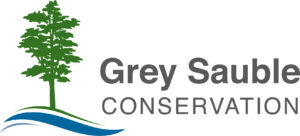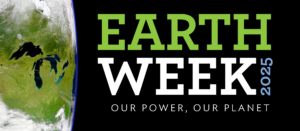EARTH WEEK 2025: Our Power, Our Planet
Overview
Bruce County Museum & Cultural Centre in partnership with Bruce Power are proud to present Our Power, Our Planet, which is also the international Earth Day theme for 2025. Through presentations prepared by guest experts, learn about energy, renewable and non-renewable sources of energy, their effects on the climate, and sustainable practices. Watch the presentations and then try the challenge/activity that accompanies each one!
Earth Week 2025 connects to the Conservation of Energy and Resources strand of Ontario’s Grade 5 Science and Technology curriculum.
Curriculum Connections: Earth and Space Systems – Conservation of Energy and Resources
Overall Expectations
- E1 Relating Science and Technology to Our Changing World: assess effects of energy and resource use on society and the environment, and suggest options for conserving energy and resources
- E2 Exploring and Understanding Concepts: demonstrate an understanding of the conservation of energy, and the forms, sources, and uses of energy and resources
Specific Expectations
- E1.1 analyse long-term impacts of human uses of energy and natural resources, on society and the environment, including climate change, and suggest ways to mitigate these impacts
- E1.2 evaluate effects of various technologies on energy consumption, and describe ways in which individuals can use technology to reduce energy consumption
- E2.1 identify a variety of forms of energy, and describe how each form is used in everyday life
- E2.2 demonstrate an understanding of the law of conservation of energy, including how energy cannot be created or destroyed but can only be transformed from one form to another
- E2.5 identify renewable and non-renewable sources of energy
VIDEOS AND CHALLENGES
Explore the energy transfer of wave action on natural and human altered shorelines of Lake Huron, considering the law of conservation of energy, the impacts of a changing climate and the potential of wave energy as a renewable power source. Build a “Beach in a Bottle” to investigate how the elements found on shorelines respond to energy transfer. Better yet, get out to the shore to experience the dynamic zone between water and land!
Learn where Ontario’s electricity comes from, the environmental impact of different energy sources, and how you can reduce your energy use. Then, explore Ontario’s power grid using a website called Gridwatch and compare Ontario’s power sources, generation, and demand. In a second activity, become an Energy Detective and sleuth out where energy is being wasted in your classroom or home.

Explore the Wonders of our Resources (Forests, Riparian Areas, and Wetlands) and learn how these ecosystems play a crucial role in combating climate change by storing water, absorbing carbon, and providing renewable resources. Then, plant a native species near a watercourse, in your schoolyard, or at home to support local biodiversity and sustainability.
Our Power, Our Planet (In Jeopardy!)
Try this interactive Jeopardy-style game test your knowledge of renewable energy and conservation. To select a number of teams and keep score, visit the game on Jeopardy Labs here, or play without keeping score here:
Meet the Experts


Kerry Kennedy: Lake Huron Coastal Centre
As Youth Education Coordinator with the Lake Huron Coastal Centre, Kerry Kennedy combines her passion for the environment with her background as a teacher and training in ecosystem restoration to support the Coastal Conservation Youth Corps – a week-long volunteer program for high school aged youth. Kerry lives in Niagara where she works as a guide with the District of Niagara Outdoor Education Centres, and during the summer season she’s based in Port Elgin fully appreciating the fragile ecosystems that exist along the shores of Lake Huron.
The Lake Huron Coastal Centre is a non-government charitable organization established in 1998 with the goal of fostering community awareness and action for a healthy Lake Huron coast, inspiring this generation to protect and restore coastal waters, life and landscapes for those that follow. The LHCC currently implements several programs, including Coast Watchers Community Science, Shoreline Cleanups, and the Coastal Conservation Youth Corps (CCYC). Outside of their projects they deliver many presentations to youth groups, municipalities, and cottagers’ associations, and have developed a large library of coastal educational materials over the past 20 years.


Dr. Stephanie Keating: Nuclear Innovation Institute
As Director of Environment at the Nuclear Innovation Institute, Stephanie Keating leads initiatives that advance environmental sustainability, clean energy and human health through innovative projects and partnerships. Key among them is The Climate Project, a hub for localized climate change research within the Saugeen Ojibway Nation Territory and Bruce, Grey and Huron Counties. Stephanie holds a PhD in Astronomy & Astrophysics from the University of Toronto and has built a career at the intersection of science, outreach and impact. She has always been passionate about equipping people with knowledge, believing that understanding our world is a crucial step toward building a more sustainable future.
The Nuclear Innovation Institute (NII) is a member-based not-for-profit organization with a vision of a Canadian landscape that celebrates an innovative nuclear industry as an integral part of the clean energy future. NII’s role driving an innovative nuclear voice, skill development and industry advancement supports members and encourages collaborative engagement with communities, industries and governments.


Chelsea Vieira: Grey Sauble Conservation Authority
Chelsea Vieira is the Environmental Educator at Grey Sauble Conservation Authority, where she shares her passion for nature by delivering engaging, hands-on programs that inspire environmental stewardship. She is dedicated to helping people of all ages connect with the natural world and understand the importance of protecting it.
Grey Sauble Conservation Authority is dedicated to protecting, managing, and conserving natural resources across our 3,200 km² watershed. Through expert-led programs, community collaboration, and nearly 30,000 acres of protected land and 172 km of trails, we work to safeguard people and property from natural hazards while fostering environmental stewardship. Our team delivers high-quality education and outreach to inspire a deeper connection with nature and empower individuals to take local action, helping reduce the risks associated with the impacts of climate change.


